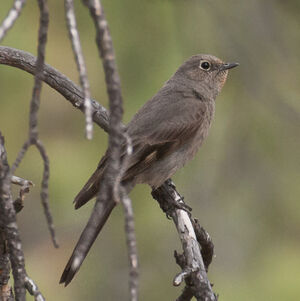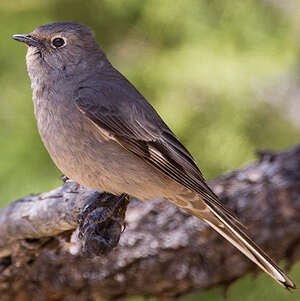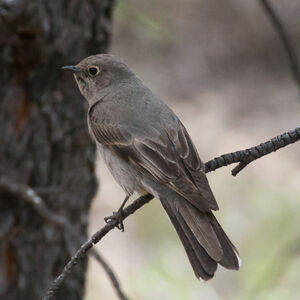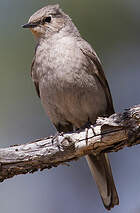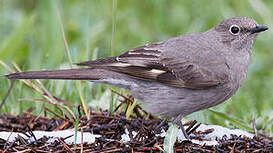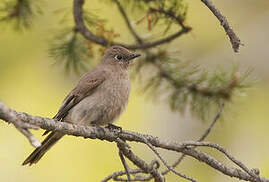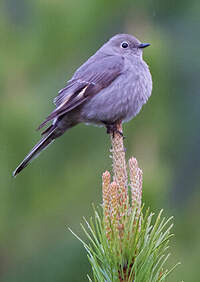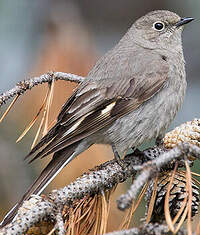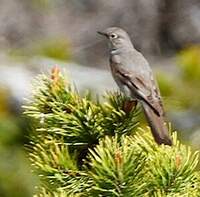Townsend's Solitaire
Myadestes townsendi - Solitaire de Townsend
Identification
Townsend's Solitaire is a medium-sized Turdidae, slightly larger than a Bluethroat, but with a very different appearance. Its long tail makes it look slender. The sexes are similar. The plumage is all shades of gray. The eye is surrounded by a white eye ring which stands out clearly against the uniform gray of the head, which may show a very vague indication of a eyebrow. The remiges and the greater coverts are darker, almost black. On them stands out clearly an area of tawny-rust forming a particular pattern on the wings. The first stain is formed at the base of the primaries, well visible on the closed wing, or in flight. The secondaries are bordered with the same color forming a longitudinal stripe on the closed wing. Finally, the primary coverts, greater coverts, and tertiaries are edged with pale, breaking the uniformity of the gray of the upper part. The primary projection is long, the wing tip going forward beyond the tail up to the mid-length. The dark tail shows white clearly visible on the outer rectrices and at its end. The under-tail coverts are gray and rimmed with whitish. The black bill is relatively small for a Turdidae of this size. The iris is dark. When observation is brief, this species could be mistaken for a mockingbird, whose silhouette is similar. But a mockingbird does not have an obvious eye ring and its pattern on the wing is different. In addition, its attitudes are very different and it is also much more demonstrative in all respects. As is usual in the family, the juvenile has plumage densely spotted on a darker background than the adult; as a result, it can be confused with a young Bluethroat, if it were not for the silhouette.
Subspecific information 2 subspecies
- Myadestes townsendi townsendi (ec Alaska to w USA)
- Myadestes townsendi calophonus (n and c Mexico)
Foreign names
- Solitaire de Townsend,
- Solitario norteño,
- tordo-nortenho,
- Townsendklarino,
- Townsend-klarinétmadár,
- Bergsolitaire,
- Solitario di Townsend,
- nordlig solitärtrast,
- Gråsolitærtrost,
- drozdovec čečinový,
- lesňák západní,
- Klarinetfugl,
- liuskerastuli,
- solitari de Townsend,
- klarnetnik północny,
- Taunsenda strazds,
- Горный дрозд-отшельник,
- ハエトリツグミ,
- 坦氏孤鸫,
- 坦氏孤鶇,
Voice song and cries
The most frequent call is a high pitched, melancholic tuu that is used to mark territory. Its song is a fairly musical, warble-like babbling, sometimes reminiscent of a finch. It's heard from an obvious perch, most often the top of a tree. In winter, it can sing to defend its food territory.
Habitat
Townsend's Solitaire nests in mountainous areas, particularly in open coniferous forests. They winter in coastal regions or in valleys with junipers. This species breeds from Alaska to northern and central Mexico. Its nesting range includes the Pacific Northwest coastline, the Sierra Nevada, the Rockies to northeastern Arizona and northwestern New Mexico. Those who nest in Alaska, Yukon Territory and British Columbia obviously migrate south, although it is not known exactly where their winter quarters are. Those who nest in the highest mountains migrate to lower altitudes, including to the west of the Great Plains. Finally, in many nesting areas, Townsend's Solitaires are sedentary and stay in place over the winter.
Behaviour character trait
The distinctive silhouette of this bird is accompanied by typical nervous movements of the wings and tail.
Otherwise, it is a quiet bird, capable of remaining motionless for long periods of time, especially outside of the breeding season.
It is a great migrator, as its wing length shows. During winter, Townsend's Solitaires defend a territory constructed around a juniper parcel. They show particularly aggressive behavior, singing from the tops of trees, performing ritual threats, chases or even fighting if necessary. There is no difference in behavior between males and females, but adults are significantly more effective than first-winter juveniles in maintaining the inviolability of their winter territory. Individuals who have failed to secure a feeding space suffer visible greater mortality. Those who have been lucky enough to acquire one remain faithful to their territory and return year after year.
Dietfeeding habits
During the breeding season, Townsend's Solitaires mainly feed on insects which they catch while flying, such as gnats, larvae and spiders, which they grab from the leaves of trees and from the ground. At the end of summer and throughout winter, their diet consists almost exclusively of berries. They consume juniper berries, real berries from other trees and other fruits. It appears that availability of juniper berries is absolutely essential for them to survive winter and make it through to spring.
Reproduction nesting
Townsend's Solitaires nest on the ground in many places, with a preference for muddy vertical riverbanks, eroded slopes, and especially embankments near roads. They also nest in hollows under rocks or tree roots. It is a cup-shaped nest made of pine needles and lined with grass and bark. Hillside nests have a bottom made of twigs. Most clutches consist of four eggs, and the female alone undertakes incubation. The eggs are of varying colors, from dull white to pink and greenish blue, with numerous spots or speckles. After hatching, both parents take care of the fledglings. They gather a large quantity of food, which they keep stored in their mouth and upper part of their digestive tube, and then return to the nest. A male captured during one such operation had stored six caterpillars and two spiders. After the flight, the adults continue to take care of their offspring, but each parent is in charge of one or more young in particular.
Threats - protection
Sources of information
- IOC World Bird List (v14.1), Gill, F and D Donsker (Eds). 2024-04-18.
Other sources of interest
 Specification sheet created on
28/10/2023 by Daniel Le-Dantec
Specification sheet created on
28/10/2023 by Daniel Le-Dantec partially rewritten on 00/00/0000 by Jean François
Translation by AI Oiseaux.net
published: 08-03-2007 - Updated: 31-12-2016
© 1996-2024 Oiseaux.net
- Accipitriformes
- Aegotheliformes
- Anseriformes
- Apodiformes
- Apterygiformes
- Bucerotiformes
- Caprimulgiformes
- Cariamiformes
- Casuariiformes
- Charadriiformes
- Ciconiiformes
- Coliiformes
- Columbiformes
- Coraciiformes
- Cuculiformes
- Eurypygiformes
- Falconiformes
- Galliformes
- Gaviiformes
- Gruiformes
- Leptosomiformes
- Mesitornithiformes
- Musophagiformes
- Nyctibiiformes
- Opisthocomiformes
- Otidiformes
- Passeriformes
- Pelecaniformes
- Phaethontiformes
- Phoenicopteriformes
- Piciformes
- Podargiformes
- Podicipediformes
- Procellariiformes
- Psittaciformes
- Pterocliformes
- Rheiformes
- Sphenisciformes
- Steatornithiformes
- Strigiformes
- Struthioniformes
- Suliformes
- Tinamiformes
- Trogoniformes

